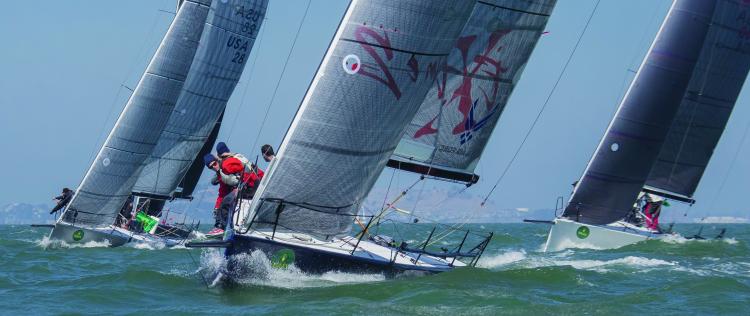Why does my boat point better on one tack?
On one tack my speed and pointing seems better than the other. Is my rig tune wrong?

More than likely, it is not rig tune but sail trim and steering technique that is the cause of a tack-to-tack speed difference while racing. Check to make sure the mast is in the center of the boat (using a centerline halyard to equi-distant points on the rail), and sight up the mainsail track while sailing upwind to make sure it is reasonably straight. If the mast is close to the center of the boat and reasonably straight, it is probably not the rig. One other source of potential frustration can be a speedo that is different from tack to tack. This is possible particularly if the impeller is not on centerline.
It is not uncommon to need different setups upwind on opposite tacks. Wave angle has the largest effect. A recent regatta in Miami provided a classic example: the starboard tack was straight into a short, nasty chop.
The trim setup had to allow the helmsperson to foot (sail lower and faster) more than usual to power through the waves. Easing the jib sheet slightly (25 to 50 millimeters from normal), moving the lead forward a similar amount, and easing the inhaul (letting the lead outboard) slightly seemed effective.
The mainsail needed more twist on starboard, bringing the traveler up (basically to the centerline) and playing the sheet to control heel. Attempting all but minimal steering to avoid waves seemed fruitless. It was better to make sure the mainsheet was eased and the boat sailing low and fast if a big set was about to be encountered. Crushing the waves with speed and a little extra heel was better than trying to steer around them. Small bites could be taken in the flatter spots. Target speed was ramped up to 6.9 or seven.
On port, the swells were almost from the side and tended to push the bow down. The boat could almost catch the waves if pressed too far. This was great for speed, but did not help height. Trimming both sails harder; with the jib lead back and more inhaul (lead further inboard) seemed to work well. In general, the mainsheet was kept on to keep the helmsperson from bearing off too far. When a fine balance was established between speed and pointing, the mainsail trimmer could sheet harder, and the helmsperson could steer slightly up and over the swell to avoid getting the bow knocked down and having the wave heel the boat over.
The traveler needed to be played more aggressively to help counteract the heeling effect of the wave action, since we tried to keep the mainsheet on. A slightly lower target speed (6.77) was used. ~ By David Flynn of Quantum Sails
This article was printed in the May 2018 issue of SpinSheet.




